Do battery operated toys hurt your young child’s development? There is a lot of debate about this issue, but we believe that ultimately, if you (and others) engage your child with the toy and your child enjoys a toy, it does not matter whether it has batteries. However, in our professional practice at The Speech Space, we lean towards more toys without batteries in our therapy and play. Toys without batteries can be more open ended, therefore, encouraging more creativity when you use them to play with your child. Additionally, if a toy is not making a battery-operated noise, your child is more likely to make noise! It is easier to encourage speech and language when a toy isn’t making noise or ‘talking’ while you play.
Here are some of our favorite battery-free toys:
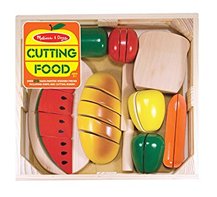
Pretend food: So versatile in the different games you can play with your child, and the vocabulary you can elicit with your child is extensive, fun, and practical! Not only are there tons of nouns (e.g., banana, plate, milk, oven, etc.), but there are countless verbs you can use that relate to your child’s everyday life (e.g., eat, drink, cut, cook, blow, etc.). With pretend food, you can encourage building your child’s understanding (technically called receptive language) by giving directions or having your child identify items by color, function and/or category. The opportunities for building their speech (technically expressive language) are also endless! Your child can label items, tell you what to do with each item (e.g. “You cut with the knife.”), explain the sequence of activities (e.g., “First we cook the food and then we eat the food.”), or simply describe what they’re doing (e.g., “I’m cutting this apple.”). We love Melissa and Doug pretend food because they are wooden (easy to clean!) and the velcro is very durable.
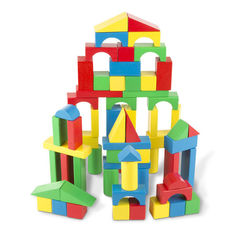
Blocks: In our professional sessions, we use wooden or cardboard blocks, but really, any blocks are great! There are so many things to build, which encourages the use of location vocabulary. For example, if your child has a superhero they love, you could decide “where” the superhero will live. Prepositions (e.g., in, on, under, next to, etc.) are easily incorporated while you play with your child. Quantity matters most with blocks – while 30 blocks may not retain your child’s interest, 100 blocks opens up many more possibilities! You can slowly build up their block collection with new blocks, or head over to eBay for some gently used blocks that are a little cheaper! Just remember to ask questions and give directions while you play and you can help your child’s speech and language development as well as their imagination!
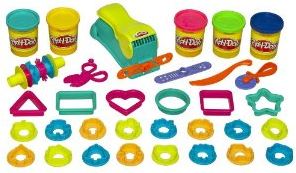
Play-Doh: Yes, Play-Doh is still around and kids still love it! The variety of Play-Doh toys is abundant and you can pick some up pretty cheap on Amazon and eBay. Playing with Play-Doh encourages the use of verbs (e.g., cutting, rolling, pushing, etc.) and nouns (e.g., colors, animals, tools, etc.). One of our favorite things to do with Play-Doh is to hide small objects in a ball of it and let your child find the object (super fun surprises!). It helps you introduce vocabulary and encourages your child to explore the Play-Doh and the object. Children love getting to rip or tear the Play-Doh apart and generally use more language when they feel like they get to be a little ‘messy’!
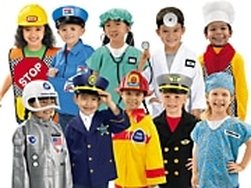
Dress Up Clothes: Again, pretending is so important for your child to try out language and everyday activities by exploring them in their own environment. You can get dress up clothes from garage sales or Goodwill or on sale after Halloween. They don’t have to be made to be “dress up clothes”! For example, if you go to Goodwill, you can often find old lab coats or fancy dresses or military gear and this could all be dress up clothes. The important thing is to play with your child and help build their imagination and language!
Sensory Table: This may be one of the messier type of toys, but so worth it! Sensory tables are great to fill with water, sand, beans or many other things you and your child want to explore together. You can change the items in the table seasonally (e.g., leaves and pinecones in the fall; sand or water in the summer; cotton balls or white pom-pom balls or shaving cream in the winter) to encourage your child’s understanding and use of a wide variety of vocabulary. Additionally, children love using a variety of senses to learn and explore and sensory tables are perfect for that!
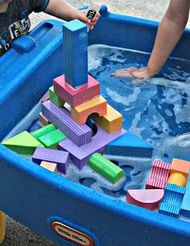
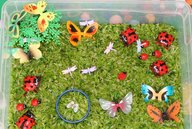
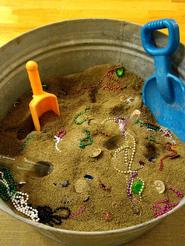
The most important thing to remember when playing with your child is to find things that interest them and encourage their engagement and attention to play with you! Play is fundamental to your child’s development – it’s the foundation of language, critical thinking and problem-solving for later in life! Children learn best through play and real interactions, so make it fun!
Come back to our blog as we continue to post about more toys and ways to monitor and support your child’s development. If you have concerns or questions about your child’s communication development, please reach out to us at The Speech Space!
